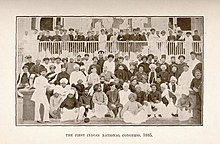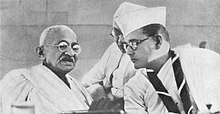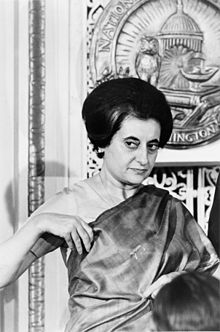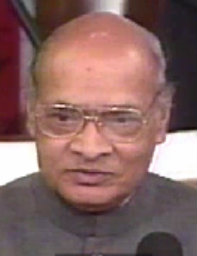Indian National Congress
| Indian National Congress भारतीय राष्ट्रीय काँग्रेस Indian National Congress |
|
|---|---|
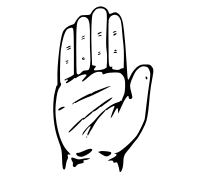
|
|
| Party leader | Sonia Gandhi |
| founding | December 28, 1885 |
| Place of establishment | Bombay , British India |
| Headquarters | New Delhi |
| Youth organization | Indian Youth Congress |
| newspaper | Congress Sandesh |
| Alignment |
Progressivism Democratic Socialism Social Democracy Left Liberalism Secularism |
| Colours) | blue |
| Lok Sabha |
52/545 |
| Rajya Sabha |
64/245 |
| Number of members | ~ 20 million |
| International connections |
Socialist International Progressive Alliance |
| Website | inc.in |
The Indian National Congress ( INC , English Indian National Congress , Hindi भारतीय राष्ट्रीय काँग्रेस Bhāratīya Rāṣtrīya Kā̃gres ), also called Congress Party or Congress , is one of currently eight "national parties" of India (as of 2021, see list of political parties in India ) and is considered to be one of the two major parties in the country alongside the Bharatiya Janata Party . It is considered to be socially liberal and secular, while the Bharatiya Janata Party stands for a conservative orientation and Hindu nationalism .
The Congress Party was founded in 1885 and is one of the oldest democratic parties in the world. It was the leading movement in the Indian struggle for independence. Numerous other, mainly regional parties have emerged from splits. For a long time it was the dominant political party in India, and most of the prime ministers and presidents of India came from its ranks .
story
Until the independence of India
The Congress Party is an Indian party founded in 1885 by Hindus and Muslims as well as the British in what was then British India . Poona was initially planned as the place of foundation . Because of an outbreak of the plague in Poona, however, they avoided going to Bombay , where the actual founding meeting took place on 28-30. December 1885 took place. The Scottish theosophist Allan Octavian Hume played a leading role in the foundation . The aim of the newly founded party was to achieve a greater participation of educated Indians in the exercise of political power in British India.
Gradually, the Congress gained political weight and played a leading role in the mass movement against the partition of Bengal in 1905 , which was seen by nationally conscious Indians as an attempt by the British colonizers to pit Muslims and Hindus against each other. The congress was also active in the Swadeshi movement from 1905 to 1911, which was intended to strengthen national Indian awareness and Indian economic power. In 1906 the rival Muslim League was founded to specifically represent the interests of Muslims. The Indian National Congress has also been fraught with conflict between the moderate wing, led by Gopal Krishna Gokhale, and the radical wing, led by Bal Gangadhar Tilak . In 1907 the Congress party split. The moderate wing called an alternative meeting every year, the All India Congress Committee , which from then on became the most important decision-making body of the National Congress. In 1916, the Indian National Congress and the Muslim League jointly drafted a declaration in the so-called Lucknow Pact with demands for Indian “self-government”, whereby initially the idea was less about complete independence and more about achieving the status of a Dominion . This was answered by the British government in August 1917 with a political declaration of intent to allow India a gradual transition to self-government.
Under the leadership of Mohanda Gandhi , who finally returned to India in 1914, there was non-violent resistance ( Satyagraha ) against British rule in the interwar period. The Congress, which had previously been an elitist group of Western educated intellectuals, became a mass movement. At the so-called Round Table Conferences 1930–32 the British colonial power recognized the Congress as a direct negotiating partner and representative of Indian interests. In 1934 the Congress Socialist Party was formed as a separate sub-group of socialists within the Congress Party. The CSP separated from the Congress Party in 1948 after independence as the Socialist Party of India .
With the Government of India Act of 1935, the provinces of British India were given relatively extensive autonomy. In the elections for the provincial councils, the Congress won a majority in 8 out of 11 provinces and then formed the provincial governments. When the war broke out in 1939, the Viceroy Lord Linlithgow declared British India to join the war on the side of the Empire without consulting the elected Indian representatives. The elected Congress Party-led provincial governments then resigned in protest. More radical representatives in the Indian National Congress saw the war as an opportunity to gain independence for India through active struggle. The former party president (1938) Subhash Chandra Bose fled abroad after the colonial government had placed him under house arrest, proclaimed a counter-government of "Free India" and built an Indian foreign army, first from Germany and later from Japan. Gandhi strove for political unity between Hindus and Muslims. In 1942, Gandhi launched the Quit India movement , which called on the British colonial rulers to leave the country. India gained independence on August 15, 1947; the predominantly Muslim parts of the country became independent as a state under the name of Pakistan . Jawaharlal Nehru , Gandhi's close ally in the ranks of Congress, became India's first prime minister.
After 1947
After India's independence in 1947, the process of transforming the National Congress from a broad mass movement into a political party, which had already begun gradually, came to an end. At the time of British colonial rule, Gandhi in particular had always attached great importance to uniting as many social groups as possible under the umbrella of the Congress in order to underpin the claim that the Congress spoke for the entire Indian population. After independence, the unifying bracket that had held various heterogeneous movements together under the umbrella of the congress organization, namely the common resistance against British colonial rule, fell away. Gradually, individual groups began to split off from the Congress party due to programmatic differences. It all started with the Congress Socialist Party, which was reorganized as the Socialist Party of India in 1948 . Numerous smaller, often regional groups followed in the following years and decades. The main opposition parties to the Congress Party in the first decades of the Indian Republic were the socialists and communists. Of lesser importance were the Hindu nationalist Bharatiya Jana Sangh , founded in 1951, and the liberal-conservative Swatantra party, which was formed in 1959 . The parliamentary elections in the 1950s and 1960s were won by the Congress Party with very large majorities. The main reason for this was the prevailing relative majority voting system, which meant that relative majorities were enough to win an electoral district and that the fragmented opposition was usually unable to agree on common candidates. From 1947 to 1977, the Congress Party consistently provided all prime ministers , beginning with Jawaharlal Nehru, and all presidents of India and dominated not only the politics of the Indian federal government, but also that of most of the states.
The Congress Party under Indira Gandhi 1966 to 1984
In 1966, Indira Gandhi , Nehru's daughter, was elected Prime Minister of India. It operated an increasingly left-wing policy, which led to increasing state regulation, especially in the economic sector. It came more and more into conflict with the old power elite of the party (the so-called "Syndicate"), so that after the latter had tried to overthrow Indira Gandhi and expel from the party in 1969, the party split into a larger one, Indira supporting Indian National Congress (Requisition) ("Congress (R)"), and a smaller Indian National Congress (Organization) ("Congress (O)"). The 1971 parliamentary election was impressively won by Indira's "Congress (R)", while the "Congress (O)" only received a few seats. Indira Gandhi remained Prime Minister. The Indian Election Commission then recognized Indiras Congress (R) as the legitimate successor of the Congress party and the suffix "R" was omitted.
The Congress Party, led by Indira Gandhi, was a much more centralist and authoritarian party than the old Nehru party. Decisions were often made by the Prime Minister alone, and a pronounced personality cult developed around the person of Indira Gandhi. Due to the two-thirds majority that her congress had achieved in parliament in 1971, she was able to have the Indian constitution changed, which has also happened several times. This was seen by their opponents as an attack on Indian democracy. During her reign there were increasing numbers of extra-parliamentary mass movements by the opposition, which Indira Gandhi saw as a threat to public order. In 1975 she therefore declared a state of emergency and ruled by decree for 21 months. After the state of emergency was suspended, parliamentary elections were held in 1977 , which ended in a heavy defeat for Indira's Congress Party. The Janata Party , which emerged from various opposition groups, won a clear victory and then formed the government - the first government since India's independence that was not supported by the Congress Party.
After the electoral defeat, Indira Gandhi's internal party opponents gained the upper hand and were expelled from the party. In 1978 the party was split again into an Indira wing, the Indian National Congress (Indira) ("Congress (I)") and a wing under D. Devaraj Urs , the Indian National Congress (Urs) ("Congress ( U) "). In a certain way, the events were repeated and Indira Gandhi's "Congress (I)" won the parliamentary election in 1980 triumphantly, so that she subsequently became Prime Minister again and the Congress (I) was recognized by the Indian Electoral Commission in 1981 as the legitimate Congress party and the suffix " I ”was removed again.
In 1984 Indira Gandhi was murdered by two Sikh assassins. President Giani Zail Singh thereupon appointed Indira's son, Rajiv Gandhi , who so far had little political experience, as her successor in the office of Prime Minister.
The Congress Party under Rajiv Gandhi from 1984 to 1991
Rajiv Gandhi took office as Prime Minister in November 1984 at a troubled time. He initially had parliamentary elections held, which he won with a large majority. Initially, he met with a lot of sympathy, since as a relatively young man he did not embody the type of professional politician. Swimming on this wave of sympathy, he initially achieved some notable successes (calming the situation in the troubled states of Assam and Punjab). However, he gambled away these initial successes through an unsteady and inconsistent policy, in which he z. B. did not implement the agreements made. His reputation was badly damaged by the Bofors scandal in 1987, in which he and those around him came under suspicion of corruption. His critics left the Congress party and joined forces with other opposition members to form a new party, the Janata Dal , which won the parliamentary election in 1989 . In this election, the Hindu nationalist Bharatiya Janata Party (BJP) also gained greater weight for the first time. Rajiv Gandhi went into opposition with his Congress party. The Janata Dal government did not last long, so new elections had to be held in 1991. During the election campaign in South India in 1991, Rajiv Gandhi suffered the same fate as his mother. He was assassinated. The assassin was a Tamil extremist.
The years between 1991 and 2004
The Congress party had to quickly name a new top candidate in the middle of the 1991 election campaign. Primary Narasimha Rao , who was not a member of the Nehru Gandhi family , was chosen . After the election , the Congress Party was able to form a minority government with Rao as Prime Minister. In a departure from the previous policy of the Congress Party, the Rao government carried out important economic reforms (deregulation, opening of the Indian market), which led to an increase in economic growth. However, the Rao government was also reached by allegations of corruption towards the end. He was also accused of not acting decisively enough against the violence between Hindus and Muslims. In the 1996 general election , the Congress Party suffered such losses that it could no longer form a government. From 1996 to 1998 there were minority governments of the Janata Dal who were tolerated by the Congress Party.
The years 1994 to 1998 were also the low point in the leadership crisis of the Congress party. There did not seem to be a convincing candidate for the office of prime minister in sight and the almost 80-year-old party president Sitaram Kesri could barely hold the party together. Little by little, parts of individual regional associations became independent parties (1994 All India Indira Congress (Tiwari) , 1996 Arunachal Congress in Arunachal Pradesh , 1997 Trinamool Congress in West Bengal , 1997 Tamil Maanila Congress in Tamil Nadu , 1997 Himachal Vikas Congress in Himachal Pradesh , 1999 Nationalist Congress Party in Maharashtra et al.). In addition, the Congress party was under pressure from the seemingly unstoppable rise of the Hindu nationalist BJP . After the parliamentary election in 1998 , which was again lost for the Congress party , Sonia Gandhi , widow of Rajiv Gandhi, a native Italian and Catholic, was persuaded by the leaders of the Congress party to take over the leadership of the party after she had refused to do so several times in previous years. She made an appeal to all dissidents to return to the Congress Party, which many (but not all) followed. In the 1999 parliamentary elections , the Congress party's share of the vote increased again, but it was not enough to return to government from the opposition.
Development since 2004
In the run-up to the 2004 parliamentary elections , the congress party under Sonia Gandhi succeeded in forging a multi-party alliance which, after the election, was formally established as the United Progressive Alliance (UPA). The Congress Party won the election together with its allies, contrary to the predictions of the election observers. To the surprise of many, Sonia Gandhi, who had been exposed to much hostility from Hindu nationalists because of her foreign origins, renounced the office of prime minister and the economist Manmohan Singh became prime minister. In the 2009 parliamentary elections , the Congress Party was able to further expand its share of votes and mandates, so that Singh served a total of 10 years. His reign was characterized by sustained high economic growth. It was not until the end of the second legislative period that the growth rate fell significantly, which was partly attributed to government failures (insufficient infrastructure expansion, lack of education, inefficient administration). During this time, several coalition partners withdrew their support from the government. The prestige of the Congress party was shaken by a series of corruption scandals. The Congress Party government, headed by the 80-year-old Singh, looked increasingly old-fashioned and inefficient, while the top candidate of the opposition, Narendra Modi (BJP) presented himself as a dynamic modernizer. Singh decided not to run again for reasons of age, and the Congress Party did not want to commit directly to a top candidate. Rahul Gandhi , Sonia Gandhi's son, was the only eligible member of the Nehru Gandhi family. He did not really work hard and, in the opinion of many observers, did not reveal the leadership qualities for such a top position. The 2014 parliamentary election ended in a disastrous defeat for the Congress party. It achieved by far the worst result in its entire party history. In the elections to the parliaments in various states after the all-India election, the Congress Party has not been able to improve its position significantly since then. Almost all parties that remained in the United Progressive Alliance, led by the Congress party , left it in the course of 2014.
Rahul Gandhi had been President of the Congress Party since December 2017, succeeding his mother. On August 10, 2019, Sonia Gandhi took over the party leadership again after Rahul Gandhi resigned as a result of the party's poor performance in the 2019 general election .
Program and criticism
Traditionally, the Congress Party was seen as the great integrative force in the Indian political landscape. She invoked the principles of Mahatma Gandhi. Her prominent role during the Indian independence movement and the respectable tradition as the oldest Indian party gave her great authority with the masses. From the beginning she emphasized the secular , religiously neutral character of the Indian state - in stark contrast to neighboring Pakistan , which defined itself as the "Islamic State" and also in contrast to the Hindu nationalists, who called for the Indian state to be based on the Hindu majority culture . She also declared herself an advocate for the underprivileged and minorities in Indian society. Therefore, for a long time, the Congress Party was elected by the large majority of Muslims and the lower castes. In terms of social policy, the Congress Party defined itself as a “socialist” party and initially spoke out in favor of an economy that was largely state-controlled and isolated from the world market. Initially, the Soviet Union was seen in many ways as a model for the industrialization of a backward agricultural country. It was not until the early 1990s that Congress Party-led governments abandoned these ideas of state monopoly and direction and liberalized the economy. In the 1990s, many Muslims and members of the lower castes also turned their backs on the Congress Party and began to vote for other parties. In addition, the Congress Party lost many voters to the much more tightly organized and disciplined Bharatiya Janata Party .
Many observers see the Congress party's fixation on the members of the Nehru Gandhi family as a major stumbling block in the party's renewal. Jawaharlal Nehru and his daughter Indira Gandhi were outstanding leaders who, despite all the criticism of the sometimes arrogant style of government, had advanced the development of Indian society. Rajiv Gandhi, the son of Indiana, owed his prime ministerial office almost exclusively to his family name. Before his mother's unexpected death, he had hardly appeared politically and had little political experience. The situation was even more extreme with Sonia Gandhi, who was not born in India at all and only got the sonorous name "Gandhi" through marriage. The fixation on the Nehru Gandhi family meant that intra-party democracy in the Congress Party only functioned to a limited extent and a broad leadership elite could not develop. At the moment there are unconvincing personalities in sight who could lead the party to power again in the near future. Some political analysts went so far as to declare Congress, India's oldest political party, to be completely obsolete, given the heavy election defeats in 2014–2016. In modern confrontational politics, a party that wants to integrate all strata of the population by consensus no longer has a livelihood. After a series of electoral defeats, the party’s prospects brightened significantly at the end of 2018 after it won the elections to the state parliaments of three important states ( Madhya Pradesh , Rajasthan , Chhattisgarh ).
After the Congress party suffered another severe election defeat in the 2019 all- India election , the number of votes calling for Rahul Gandhi to be voted out as party president increased. The party faces the choice of either changing its leadership or risking its decline into complete insignificance.
Election symbols
Since a considerable part of the Indian voters are still illiterate (with the independence of India it was over 80% of the population), all political parties were assigned symbols by the Indian Electoral Commission, which were also shown on the ballot papers or on the boards of the electronic voting machines are shown. Parties that are recognized as “national parties” like the Congress Party may use the same symbol nationwide.
Election results
| Abbreviation | background |
|---|---|
| Congress (R) | "Congress (Requisition)"; after the split of the Congress Party in 1969, a larger wing of the Congress Party under the leadership of Indira Gandhi, 1972 removal of the suffix "R" |
| Congress (O) | “Congress (Organization)”; After the split of the Congress Party in 1969, a smaller wing of the Congress Party under the leadership of the old power elite, was absorbed into the Janata Party in 1977 |
| Congress (I) | "Congress (Indira)"; After the split in the Congress Party in 1978, the wing under Indira Gandhi was created; in 1982 the addition "Indira" or "I" was removed |
| Congress (U) | "Congress (Urs)"; After the split of the Congress party in 1978, the wing was created under D. Devaraj Urs , renamed Congress (S) in 1981 |
| Congress (S) | "Congress (Socialist)"; emerged from the Congress (U) by renaming in 1981, largely reunited with the Congress Party in 1986 |
| Congress (T) | "Congress (Tiwari)", a split that occurred in 1994 under the former Chief Minister of Uttar Pradesh Narayan Dutt Tiwari , reunited with the Congress Party in 1998 |
The following table shows the election results (seats won) in the all-India parliamentary elections. In the course of its history the Congress Party has been subject to several divisions. For the 1971 and 1980 election, the results of Indira Gandhi's Congress Party (Congress (R) and Congress (I)) are listed here.
| year | choice | voting share |
Seats in parliament |
|---|---|---|---|
| 1951 |
|
44.99% |
364/489 |
| 1957 |
|
47.78% |
371/494 |
| 1962 |
|
44.72% |
361/494 |
| 1967 |
|
40.78% |
283/520 |
| 1971 |
|
43.68% |
352/518 |
| 1977 |
|
34.52% |
154/542 |
| 1980 |
|
42.69% |
353/529 |
| 1984 |
|
49.10% |
404/514 |
| 1989 |
|
39.53% |
197/529 |
| 1991 |
|
36.26% |
232/521 |
| 1996 |
|
28.80% |
140/543 |
| 1998 |
|
25.82% |
141/543 |
| 1999 |
|
28.30% |
114/543 |
| 2004 |
|
26.53% |
145/543 |
| 2009 |
|
28.55% |
206/543 |
| 2014 |
|
19.30% |
44/543 |
| 2019 |
|
19.70% |
52/543 |
See also
- List of Presidents of the Indian National Congress
- Natal Indian Congress
- Nationalist Congress Party
- BJP (Indian People's Party)
Web links
Individual evidence
- ^ Indian National Congress. Encyclopaedia Britannica, accessed July 11, 2015 .
- ^ Praveen Rai, Sanjay Kumar: The Decline of the Congress Party in Indian Politics . In: Economic & Political Weekly . tape 52 , no. 12 , March 25, 2017, ISSN 2349-8846 (English).
- ↑ John Stewart Bowman: Columbia Chronologies of Asian History and Culture . Ed .: John Stewart Bowman. Columbia University Press, 2000, ISBN 0-231-11004-9 , pp. 300 (English, limited preview in Google Book Search [accessed January 10, 2017]).
- ↑ RFA No. 2011 OF 2005. (PDF) Karnataka High Court in Bangalore, October 11, 2013, pp. 11-13 , accessed on April 18, 2016 (English, court judgment with a brief recap of the story).
- ↑ India's corruption scandals. BBC News, April 18, 2012, accessed October 16, 2015 .
- ↑ CWC meeting: Rahul's resignation accepted, Sonia Gandhi becomes Congress interim president. August 10, 2019, accessed November 12, 2019 .
- ^ Klaus Julian Voll: The Congress party: Social democracy or family business? Heinrich Böll Foundation, March 31, 2014, accessed on May 18, 2015 (English).
- ↑ Sitaraman Shankar: The need for reform in Indian National Congress party. al Jazeera, August 16, 2016, accessed April 28, 2017 .
- ↑ Keshava Guha: The party's over: Why India doesn't need the Congress anymore. scroll.in, May 27, 2016, accessed on April 28, 2017 (English).
- ^ Milan Vaishnav: India's Congress Party Rises from the Dead. foreignpolicy.com, December 14, 2018, accessed March 8, 2019 .
- ↑ View: Rahul Gandhi can't be fixed, Congress needs to accept this. The Economic Times, June 1, 2019, accessed June 1, 2019 .
- ^ Election Results - Full Statistical Reports. Indian Election Commission, accessed October 12, 2014 (English, election results of all Indian elections to the Lok Sabha and the parliaments of the states since independence).
